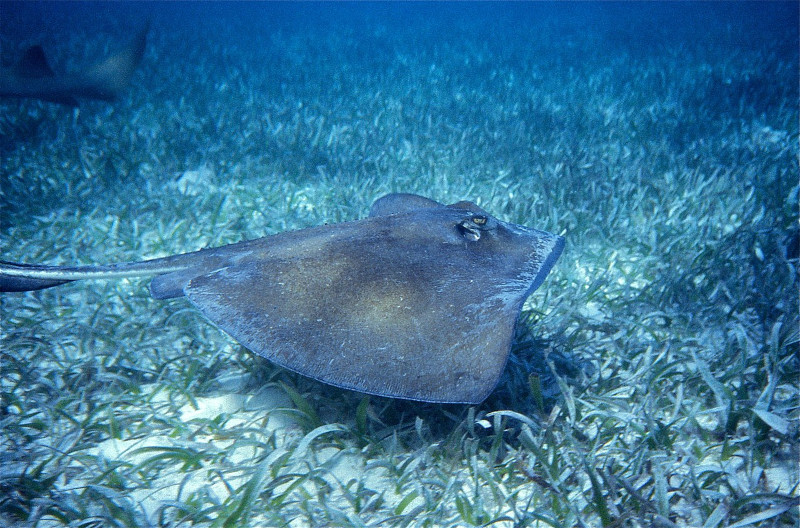
Southern Stingray Facts
- This marvelous marine beauty most frequently goes by the somewhat descriptive common name of the Southern Stingray. Like most species, though, it’s known by a few other terms, too. These include such varied titles as stingaree, kit, and whip stingray.
- Among scientific professionals, however, it’s perhaps better known by its technical moniker. That’s actually a simple term for the layperson to pronounce, relatively speaking. That’s because the fish bears the formal name of the Hypanus americanus.
- It received that particular appellation due to the efforts of a dup of American Ichthyologists. Samuel Hildebrand and William Schroeder accomplished the first recognition of it as a separate and distinct species. The team managed that in 1928.
- Regardles of which term one chooses to use, it remains an impressive creature. Though certainly potentially dangerous to humans if provoked, it’s normally quite docile in temperament. It’s commonly seem swimming alongside snorkelers and divers.
- Sadly, the population numbers of the Southern Stingray appear to be in decline. This lamentable situation also seems to hold true throughout the entirety of its native range. The IUCN therefore currently lists the animal as Near Threatened on its Red List.
- It faces multiple threats to its continued existence as a species. Like most creatures, most of these stem from the actions of man. Some of the dangers it faces include accidental bycatch, habitat degradation or loss, and the effects of climate change.
Related Articles
Porcupine Ray
Southern Stingray Physical Description
The amazing Southern Stingray represents an approximately average-sized member of its Order. The animal nevertheless merits its own level of appreciation. The marine creature still possesses characteristics that make it worthy of note and respect from mankind.
Like the majority of its relatives, the intriguing fish also presents a certain degree of the physiological trait of sexual dimorphism. In its case, this manifests itself in terms of simple measurements. Specifically, the females attain greater average dimensions than the male.
The difference is greater than in some species, though. Females typically reach a maximum disc width of roughly 59 in (150 cm). The males, however, rarely exceed 26 in (67 cm) in this aspect. Though quite rare, exceptional examples do occur, regardless of gender.
Again following the pattern of other rays, this species has a highly flattened body shape. It’s diamond-shaped in design, and also much more angular than others of its kind. This unique characteristic easily distinguishes it from the many other species in its Order.
The upperside of the body of the Southern Stingray generally presents a background that ranges from dark green to olive-brown in adults. In the young, this appears as dark gray. Meanwhile, the underside most often shows degrees of a dull, off-white shade.
Its eyes also develop on the top of the flat body, along with the spiracles, through which it breathes. The tail develops as extremely elongated, measuring significantly longer than the disc. At its base, this impressive appendage also hosts a lengthy, serrated spine.
- Kingdom: Animalia
- Phylum: Chordata
- Class: Chondrichthyes
- Order: Myliobatiforme
- Family: Dasyatidae
- Genus: Hypanus
- Species: H. americanus
Southern Stingray Distribution, Habitat, and Ecology
The fabulous Southern Stingray evolved as native to a small and specific range of the oceans of the world. For most people, though, the location of that zone of habitation likely won’t come as any surprise. The marvel of Nature lives in the greater area of the Atlantic Ocean.
But, within that larger range, the fish only inhabits specific sections of it. That area begins roughly in the northwest and western central part of the ocean. This extends from the coast of New Jersey, in the United States, offshore of the continent of North America.
From there, though, its home territory extends southward as far as the coastal waters of Brazil, in South America. Yet that natively evolved range also extends into several other marine waters of the earth. These others include the Gulf of Mexico and the Caribbean.
Despite this larger overall area, the marvelous fish displays decided strong preferences for its choice of habitat. These effectively curtail its choices of where to live rather significantly. For one, it’s never been known to appear at depths greater than 328 ft (100 m).
The animal almost exclusively inhabits regions of sandflats. Yet the precision of its needs don’t end there. These sites further need to be located comparatively close to coral reefs and/or seagrasses. The nature of the combination naturally limits its expansion.
Given its basic nature, the Southern Stingray understandably developed as carnivorous. It preys on and consumes a wide variety of available species. This essentially includes any smaller fish, crustaceans, worms, and molluscs it finds opportunistically.
In turn, this magnificent animal has only a handful of natural predators. The few creatures known to eat it include larger sharks, such as the Scalloped Hammerhead. In most instances, the venomous spines in its tail tend tobe successful in discouraging potential threats.
Species Sharing Its Range
Check out our other articles on 4 Supremely Stunning Squirrels, Great Potoo, Victoria Falls, Moose, Kinnikinnick, Australian Painted Lady, Alligator Snapping Turtle, Axolotl, Serval
